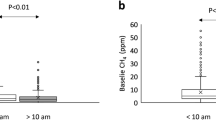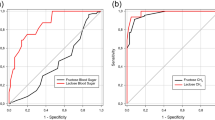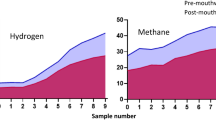Abstract
Background:
Lactose hydrogen breath tests (H2-BTs) are widely used to diagnose lactase deficiency, the most common cause of lactose intolerance. The main time-consuming part of the test relates to the sampling frequency and number of breath samples.
Aim:
Evaluate sensitivities and specificities of two- and three-sample breath tests compared with standard breath sampling every 15 min.
Methods:
Lactose H2-BT with probes samples every 15 min served as gold standard. Sensitivity, specificity, positive and negative predictive value of two-sample tests (0–60 min, 0–90 min or 0–120 min) and three-sample tests (0–60–90 min, 0–60–120 min or 0–90–120 min) were calculated.
Results:
Among 1049 lactose H2-BT performed between July 1999 and December 2005, 337 (32%) had a positive result. Two-sample tests had sensitivity and specificity of 52.5 and 100.0% (0–60 min), 81.9 and 99.7% (0–90 min), and 92.6 and 99.2% (0–120 min), respectively. Three-sample tests had sensitivity and specificity of 83.4 and 99.7% (0–60–90 min), 95.0 and 99.2% (0–60–120 min), and 95.0 and 98.9% (0–90–120 min), respectively.
Conclusion:
A three-sample breath test (baseline, 60/90 min and 120 min) has excellent sensitivity and specificity for lactase deficiency. Lactose H2-BT can be simplified but not shortened to <2 h.
This is a preview of subscription content, access via your institution
Access options
Subscribe to this journal
Receive 12 print issues and online access
$259.00 per year
only $21.58 per issue
Buy this article
- Purchase on Springer Link
- Instant access to full article PDF
Prices may be subject to local taxes which are calculated during checkout


Similar content being viewed by others
References
Abramowitz A, Granot E, Tamir I, Deckelbaum RJ (1986). Two-hour lactose breath hydrogen test. J Pediatr Gastroenterol Nutr 5, 130–133.
Anh NT, Thuc TK, Welsh JD (1977). Lactose malabsorption in adult Vietnamese. Am J Clin Nutr 30, 468–469.
Bayless TM, Rothfeld B, Massa C, Wise L, Paige D, Bedine MS (1975). Lactose and milk intolerance: clinical implications. N Engl J Med 292, 1156–1159.
Casellas F, Malagelada JR (2003). Applicability of short hydrogen breath test for screening of lactose malabsorption. Dig Dis Sci 48, 1333–1338.
Densupsoontorn N, Jirapinyo P, Thamonsiri N, Chantaratin S, Wongarn R (2004). Lactose intolerance in Thai adults. J Med Assoc Thai 87, 1501–1505.
Di Camillo M, Marinaro V, Argnani F, Foglietta T, Vernia P (2006). Hydrogen breath test for diagnosis of lactose malabsorption: the importance of timing and the number of breath samples. Can J Gastroenterol 20, 265–268.
Ehrenpreis ED, Swamy RS, Zaitman D, Noth I (2002). Short duration exercise increases breath hydrogen excretion after lactulose ingestion: description of a new phenomen. Am J Gastroenterol 97, 2798–2802.
Enattah NS, Sahi T, Savilahti T, Terwilliger JD, Peltonen L, Järvela I (2002). Identification of a variant associated with adult-type hypolactasia. Nat Genet 30, 233–237.
Farup PG, Monsbakken KW, Vandvik PO (2004). Lactose malabsorption in a population with irritable bowel syndrome: prevalence and symptoms. A case-control study. Scand J Gastroenterol 39, 645–649.
Ford DC, James C, Armstrong D (2002). Lactose hydrogen breath test for the diagnosis of lactose intolerance: hourly breath samples are adequate. Canadian Digestive Disease Week, Abstract, http://www.pulsus.com/cddw2002/abs/abs161.htm; last accessed 09 November 2010.
Gasbarrini A, Corazza GR, Gasbarrini G, Montalto M, Di Stefano M, Basilisco G et al (2009). Methodology and indications of H2-breath testing in gastrointestinal diseases: the Rome Consensus Conference. Aliment Pharmacol Ther 29 (Suppl 1), 1–49.
Gudmand-Hoyer E (1994). The clinical significance of disaccharide maldigestion. Am J Clin Nutr 59, 735–741.
Metz G, Jenkins DJ, Peters TJ, Newman A, Blendis LM (1975). Breath hydrogen as a diagnostic method for hypolactasia. Lancet 1, 1155–1157.
Newcomer AD, McGill DB, Thomas PJ, Hofmann AF (1975). Prospective comparison of indirect methods for detecting lactase deficiency. N Engl J Med 293, 1232–1236.
Pohl D, Savarino E, Hersberger M, Behlis Z, Stutz B, Goetze O et al. (2010). Excellent agreement between genetic and hydrogen breath tests for lactase deficiency and the role of extended symptom assessment. Br J Nutr 19, 1–8.
Rosado JL, Solomons NW (1983). Sensitivity and specificity of the hydrogen breathanalysis test for detecting malabsorption of physiological doses of lactose. Clin Chem 29, 545–548.
Rosenthal A, Solomons NW (1983). Time-course of cigarette smoke contamination of clinical hydrogen breath-analysis tests. Clin Chem 29, 1980–1981.
Solomons NW (2002). Fermentation, fermented tools and lactose intolerance. Eur J Clin Nutr 56 (Suppl 4), S50–S55.
Solomons NW, García-Ibáñez R, Viteri FE (1980). Hydrogen breath test of lactose absorption in adults: the application of physiological doses and whole cow’s milk sources. Am J Clin Nutr 33, 545–554.
Suarez FL, Savaiano DA, Levitt MD (1995). A comparison of symptoms after the consumption of milk or lactose-hydrolyzed milk by people with self-reported severe lactose intolerance. N Engl J Med 333, 1–4.
Thompson DG, Binfield P, De Belder A, O’Brien J, Warren S, Wilson M (1985). Extra intestinal influences on exhaled breath hydrogen measurements during the investigation of gastrointestinal disease. Gut 26, 1349–1352.
Tolliver BA, Herrera JL, DiPalma JA (1994). Evaluation of patients who meet clinical criteria for irritable bowel syndrome. Am J Gastroenterol 89, 176–178.
Veligati LN, Treem WR, Sullivan B, Burke G, Hyams JS (1994). Delta 10 ppm versus delta 20 ppm: a reappraisal of diagnostic criteria for breath hydrogen testing in children. Am J Gastroenterol 89, 758–761.
Vernia P, Ricciardi MR, Frandina C, Bilotta T, Frieri G (1995). Lactose malabsorption and irritable bowel syndrome. Effect of a long-term lactose-free diet. Ital J Gastroenterol 27, 117–121.
Vogelsang H, Ferenci P, Frotz S, Meryn S, Gangl A (1998). Acidic colonic microclimate-possible reason for false negative hydrogen breath tests. Gut 29, 21–26.
Author information
Authors and Affiliations
Corresponding author
Ethics declarations
Competing interests
The authors declare no conflict of interest.
Rights and permissions
About this article
Cite this article
Oberacher, M., Pohl, D., Vavricka, S. et al. Diagnosing lactase deficiency in three breaths. Eur J Clin Nutr 65, 614–618 (2011). https://doi.org/10.1038/ejcn.2010.287
Received:
Revised:
Accepted:
Published:
Issue Date:
DOI: https://doi.org/10.1038/ejcn.2010.287
Keywords
This article is cited by
-
A new strategy based on real-time secondary electrospray ionization and high-resolution mass spectrometry to discriminate endogenous and exogenous compounds in exhaled breath
Metabolomics (2014)
-
Hydrogen Breath Tests in Gastrointestinal Diseases
Indian Journal of Clinical Biochemistry (2014)



